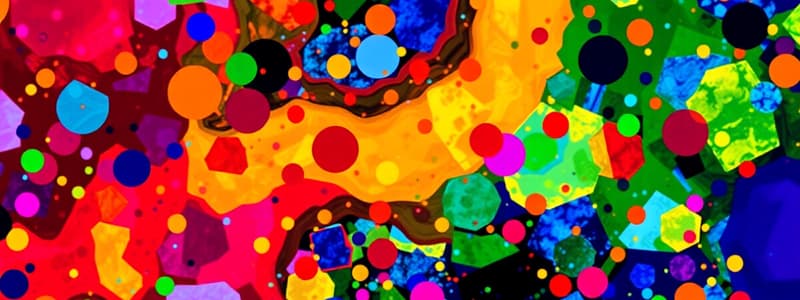Podcast
Questions and Answers
Which of the following best defines a niche in an ecosystem?
Which of the following best defines a niche in an ecosystem?
- The physical environment of a particular organism
- The role an organism plays in its ecosystem, including habitat and feeding relationships (correct)
- The geographical location of a species
- The number of organisms in a population
Keystone species have minimal impact on their ecosystem.
Keystone species have minimal impact on their ecosystem.
False (B)
What is the impact of habitat destruction on biodiversity?
What is the impact of habitat destruction on biodiversity?
Habitat destruction reduces biodiversity by eliminating the homes and resources necessary for various species to survive.
Reduced genetic diversity in populations leads to an increased risk of __________.
Reduced genetic diversity in populations leads to an increased risk of __________.
Match the following ecological terms with their definitions:
Match the following ecological terms with their definitions:
What is the primary benefit of an internationally agreed system of nomenclature?
What is the primary benefit of an internationally agreed system of nomenclature?
Higher biodiversity contributes to the stability of an ecosystem.
Higher biodiversity contributes to the stability of an ecosystem.
Define biodiversity.
Define biodiversity.
A ______ is a specific group of organisms that can interbreed and produce fertile offspring.
A ______ is a specific group of organisms that can interbreed and produce fertile offspring.
Match the following biological classification levels with their descriptions:
Match the following biological classification levels with their descriptions:
Which of the following is NOT one of the categories included in biodiversity?
Which of the following is NOT one of the categories included in biodiversity?
Biological classification groups organisms based solely on their habitat.
Biological classification groups organisms based solely on their habitat.
What does a higher biodiversity indicate about an ecosystem?
What does a higher biodiversity indicate about an ecosystem?
What type of immunity is acquired through maternal antibodies?
What type of immunity is acquired through maternal antibodies?
Active immunity can only be acquired through vaccination.
Active immunity can only be acquired through vaccination.
The higher the biodiversity of an ecosystem, the more ________ it is.
The higher the biodiversity of an ecosystem, the more ________ it is.
Match the following terms with their descriptions:
Match the following terms with their descriptions:
What is the primary benefit of classifying organisms biologically?
What is the primary benefit of classifying organisms biologically?
Scientific names and common names for species are always the same.
Scientific names and common names for species are always the same.
What is an example of an ecosystem?
What is an example of an ecosystem?
Flashcards
Biodiversity
Biodiversity
The variety of all living things, including genetic, species, and ecosystem diversity.
Species
Species
A group of organisms that can reproduce and create fertile offspring.
Population
Population
A group of the same species living together in the same area.
Ecosystem
Ecosystem
Signup and view all the flashcards
Scientific Names
Scientific Names
Signup and view all the flashcards
International Nomenclature
International Nomenclature
Signup and view all the flashcards
Biological Classification
Biological Classification
Signup and view all the flashcards
Species similarity
Species similarity
Signup and view all the flashcards
Passive Immunity
Passive Immunity
Signup and view all the flashcards
Active Immunity
Active Immunity
Signup and view all the flashcards
Ecological Niche
Ecological Niche
Signup and view all the flashcards
Keystone Species
Keystone Species
Signup and view all the flashcards
Habitat Destruction Impacts
Habitat Destruction Impacts
Signup and view all the flashcards
Predicting Change Impacts
Predicting Change Impacts
Signup and view all the flashcards
Genetic Diversity for Survival
Genetic Diversity for Survival
Signup and view all the flashcards
Study Notes
Stage 1 Biology - Key Ideas
- Design investigations with clear questions and potential solutions, possibly with implementation.
- Critique proposed investigations.
- Use findings from one experiment to develop subsequent experiments.
- Alter an independent variable to modify an experiment.
- Improve existing experimental procedures.
- Select appropriate methods for measuring dependent variables.
- Identify appropriate data collection types and volumes.
- Consider ethical and safety factors.
Representing Results
- Use appropriate SI units and symbols.
- Construct properly labeled tables.
- Create graphs (linear, non-linear, best-fit lines).
- Use significant figures.
- Choose and use appropriate representations (diagrams, equations, ratios, mathematical relationships).
- Explain concepts, solve problems, and make predictions using representations.
Data Analysis
- Identify trends, patterns, and relationships in data.
- Use interpolation/extrapolation when relevant.
- Select relevant evidence and scientific understanding to draw and justify conclusions.
Evaluating Uncertainty
- Identify sources of uncertainty (random and systematic errors).
- Evaluate the impact of uncertainty on experimental results.
- Consider repetition, sample size, accuracy, reliability, precision, and validity.
- Control variables effectively.
- Recognize limitations of conclusions.
Communication
- Communicate findings to specific audiences for specific purposes.
- Use appropriate language, terminology, conventions.
Microorganisms
- Microorganisms (bacteria, fungi, protists) are important living entities.
- Bacteria populations increase exponentially under ideal conditions.
- Factors affecting bacterial growth include temperature, nutrient availability, moisture, pH.
- Microorganisms decompose waste, recycling essential nutrients.
- Bacteria reproduce asexually.
- They play a role in human digestion, oxygen production, recycling, and genetic engineering.
- Humans have used microorganisms for about 10,000 years for preservation.
- Microbes cause food spoilage and controlled growth is crucial for preservation.
- Preserved food preparation techniques involve heat, cold, acids, salts, and sugar.
- Microbes cause infectious diseases.
- Distinguish infectious from non-infectious diseases.
- Pathogens have characteristics and transmission methods (air, dust, direct contact, faeces, food).
- Infectious diseases are interrelated with factors like pathogen persistence, transmission method, immunity levels and population mobility.
Pathogens and the Immune System
- Pathogens have traits enabling them to invade cells/tissues.
- Molecular recognition is key for entry and survival.
- Pathogens trigger an immune response.
- Antigens are substances that stimulate an immune response.
- Foreign vs. self-antigens are distinguished.
- The immune system (physical barriers, innate, adaptive) protects against infections.
- Adaptive immune response reacts to foreign antigens.
- Exposure to antigens leads to immunity—passive or active, through natural exposure to a pathogen or vaccination, or through antibody serum injections.
Biodiversity and Ecosystems
- Biodiversity includes variety in genetics, species, and ecosystems.
- Distinguish between species, populations, communities, and ecosystems.
- High biodiversity promotes ecosystem stability.
- Biological classification is hierarchical and relies on shared structures and molecular information.
- Nomenclature is a standardized system.
- Organisms have adaptations for survival and reproduction.
- Ecosystem components (biotic and abiotic) interact and establish relationships (e.g. energy flow, nutrient cycles).
- Understanding diversity, interactions, and keystone species is essential for healthy ecosystems.
- Human activities significantly impact ecosystems.
- Genetic diversity is essential for species' survival.
Studying That Suits You
Use AI to generate personalized quizzes and flashcards to suit your learning preferences.
Related Documents
Description
This quiz covers essential concepts related to designing scientific investigations in Stage 1 Biology. It focuses on data representation, analysis, and improving experimental procedures. Additionally, it emphasizes understanding trends and relationships in biological data.



